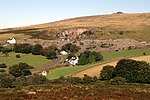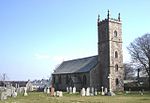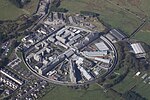King Tor Halt railway station
Disused railway stations in DevonFormer Great Western Railway stationsPages with no open date in Infobox stationRailway stations in Great Britain closed in 1956Railway stations in Great Britain opened in 1928 ... and 1 more
Use British English from May 2013

King Tor Halt railway station was located on the 10.5 mile long single track branch railway line in Devon, England, running from Yelverton to Princetown with four intermediate stations. It was opened with only a basic wood platform and shelter in connection with the adjacent granite quarry and the associated worker's houses. Its later traffic was entirely walkers and like Ingra Tor Halt it was retained in an attempt to counter competition from local bus services and encourage tourist traffic.
Excerpt from the Wikipedia article King Tor Halt railway station (License: CC BY-SA 3.0, Authors, Images).King Tor Halt railway station
Abandoned tramway, West Devon Dartmoor Forest
Geographical coordinates (GPS) Address Nearby Places Show on map
Geographical coordinates (GPS)
| Latitude | Longitude |
|---|---|
| N 50.5409 ° | E -4.0261 ° |
Address
King Tor Halt
Abandoned tramway
PL20 6SS West Devon, Dartmoor Forest
England, United Kingdom
Open on Google Maps









